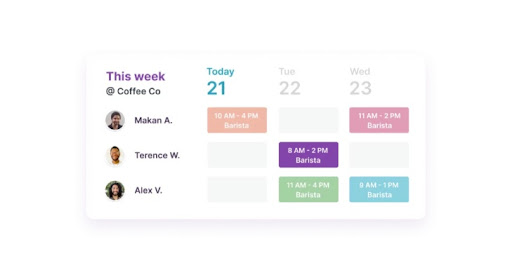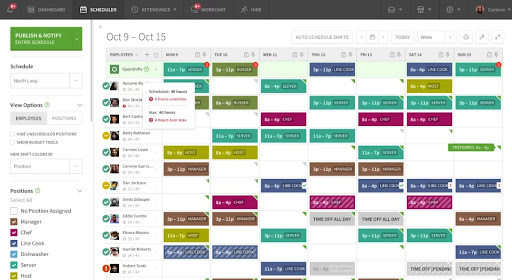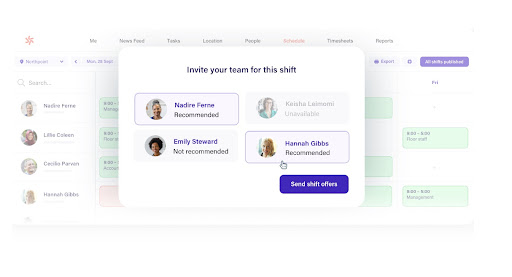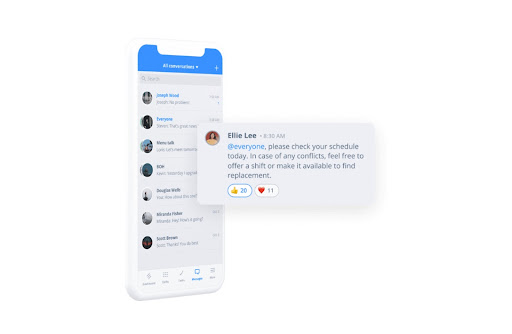If you have employee shifts to manage, you know you need a robust schedule maker. Digital platforms save time, reduce errors, and enable you to schedule many employees at once.
Plus, some even integrate with other core functions like time tracking, communication, payroll, and compliance, making scheduling more accurate and staff coordination simple.
But with so many schedulers out there, it can be complicated and time-consuming to know which will work best for your business. Comparing their features, pricing, and strengths — and even knowing what to look for — can be a full-time job in itself.
So we’ve done the hard work for you. In this post, we cover:
- The key features to look for in shift schedule makers, so you know what to keep in mind
- Our top 10 shift schedule makers (and our pick for the best all-in-one option)
- What to consider when buying a shift schedule maker
- And common pitfalls to avoid when using the tool, to get optimum results
Key features to look for in shift schedule makers
We recommend looking for the following features when choosing a shift schedule maker for your business.
- Employee availability tracking — It’s crucial to have a scheduler that can keep track of team members’ availability and set shifts accordingly. It should also alert you if you accidentally try to schedule a shift for an employee at a time when they’re not available.
- Shift swapping and trade management — Enabling employees to easily trade shifts gives them autonomy and lets them figure out last-minute changes to their availability without requiring you to change up the schedule for them. This avoids no-shows or last-minute lack of staff.
- Automated schedule generation — You can save hours of time with a tool that lets you save templates and create schedules automatically, taking into account availability and the staff members you need.
- Mobile accessibility — A must for managers and team members who may not work from computers or laptops, or need access to their schedule on the go. This also lets you send alerts and updates via text or app notifications, to ensure that everyone sees the schedule.
- Integration with time and attendance tracking — A scheduler tool that also tracks time and attendance will help you see who’s working and when, while providing a clear picture of availability. It also ensures you avoid expensive overtime shifts and stay legally compliant on hours per worker.
Our top shift schedule maker pick in 2023 (+ the best of the rest)
Of course, we’re biased, but we believe Homebase is one of the best shift schedulers out there because it offers an all-in-one dashboard that lets you manage scheduling as well as time tracking, availability, and team communication.
But no tool is exactly right for everyone, and there are others available that could work better for your business, depending on what you need. Let’s take a look.
- Best all-in-one solution: Homebase
- Best for simplicity: When I Work
- Best for larger teams: Shiftboard
- Best for staff communication: 7shifts
- Best for time clocks: Deputy
- Best for ease of use: Connecteam
- Best for free features: Clockify
- Best for scheduling alone: ZoomShift
- Best for hourly teams: Sling
- Best for automation: Humanity
Comparison chart: Top 10 shift schedule makers in 2023
| Software | Scheduling | Time tracking | Team comms | Payroll | Mobile app | Free plan | Pricing |
 |
✓ | ✓ | ✓ | ✓ | ✓ | ✓ | Plans range from free to $100 per location per month
Homebase payroll costs $39/month base fee and $6/month per active employee. |
| ✓ | ✓ | ✓ | X | X | From $4-$8 per user per month. | ||
| ✓ | ✓ | ✓ | X | ✓ | X | Shiftboard does not publish pricing publicly. | |
 |
✓ | ✓ | ✓ | ✓ | ✓ | Free for 30 employees. From $29.99 to $135 per month. | |
 |
✓ | ✓ | ✓ | X | ✓ | ✓ | Free for 100 shifts per month.
From $3.50 to $4.90 per user per month. |
| ✓ | ✓ | ✓ | X | ✓ | ✓ | Free for 10 users. From $29 to $99 per month. | |
| ✓ | ✓ | X | X | ✓ | ✓ | Free. | |
 |
✓ | ✓ | X | X | ✓ | X | From $2 to $4 per month. |
 |
✓ | ✓ | ✓ | X | ✓ | ✓ | Free. |
 |
✓ | ✓ | ✓ | X | ✓ | ✓ | Humanity does not publish pricing publicly. |
A breakdown of the 10 best shift schedule makers
1. Best all-in-one solution: Homebase

Source: https://joinhomebase.com/employee-scheduling/
Caption: Homebase makes it easy to see shifts for each worker, and integrates with other key employer tasks.
Homebase’s schedule maker not only lets you add staff availability, and enable shift trading, team communication, and time tracking. It also integrates with other native tools for essential employee management tasks, like hiring and onboarding, HR and compliance, payroll, and employee perks.
This makes it a one-stop shop for your hourly employee needs, with optimized and smart scheduling just one cog in your wider management machine.
Top features
- New schedule notifications for team members by text, app notification, and email.
- App capability for iOS and Android.
- Templates and automation for easy-to-build schedules and optimized shifts.
- Integration with staff availability and PTO to avoid clashes.
- Alerts to avoid expensive overtime or breaches of working time compliance.
- Team communication for easy shift swapping.
- Integration with time clocking to keep close track of employee hours.
- Integration with Payroll to track hours and scheduling, and pay accurately.
Pros and cons
- Pros: All-in-one, with scheduling just one of a wide range of employee management tools.
- Cons: You may not need all of the tools if you’re looking for a scheduling platform only.
Users praise how “easy it is to build a schedule,” with extra features for other tasks like hiring and interviewing “comparable to much more expensive software.”. Reviewers also love the “clean design,” mobile app that is easy for employees to use every day.
Pricing
- Basic: Free. Track hours and manage schedules. Includes messaging. One location, for a staff of up to 20 people.
- Essentials: $24.95 per month per location. Everything included in the Basic plan, plus advanced scheduling and time tracking, team communication, remote team, and payroll integration tools.
- Plus: $59.95 per month per location. Everything in Essentials, plus hiring, retention and performance tracking, time-off management, departments and permissions tools.
- All-in-one: $99.95 per month per location. Everything in Plus, as well as new hire onboarding, HR & compliance, labor cost management, and business insights tools.
2. Best for simplicity: When I Work

Source: https://wheniwork.com/features/employee-scheduling-software
Caption: When I Work has a color-coded calendar view.
When I Work describes its product as “scheduling and more”, and it focuses on the key tasks of scheduling creation, time tracking, and team messaging. With color-coded schedules, easy notification settings, and a mobile app, it’s simple and straightforward, and designed with hourly staff in mind.
Top features
- Employee scheduling, with easy-to-build calendars and instant sharing capabilities.
- Team messaging, for easy in-platform communication, without the sharing of personal numbers.
- Time clock, to track attendance, breaks, and PTO and incorporate it into your schedule.
- Timesheets, to ensure accurate tracking of employee hours and shifts worked.
Pros and cons
- Pros: What it does, it does well — specializing in a few scheduling tasks for simplicity and function.
- Cons: Focuses mainly on scheduling and time tracking, unlike some more all-in-one tools.
Users of When I Work praise it for being “easy to navigate” and straightforward,” and positive “mobile app experience.”
Pricing
- Standard: $4 per user per month. Includes standard scheduling, and time and attendance tools.
- Advanced: $8 per user per month. Includes advanced scheduling with more dynamic and customizable features, plus time and attendance tools.
3. Best for larger teams: Shiftboard

Source: www.shiftboard.com
Caption: Shiftboard offers a wide range of options designed to manage large teams.
Shiftboard specializes in automation-driven scheduling for large teams and enables managers to optimize shifts, manage timesheets, plan labor needs, and engage workers, all within the same platform.
Top features
- Scheduling automation, for adaptive schedules that automatically take availability into account.
- Worker engagement, to ensure schedules are worker-friendly and don’t require excess overtime.
- Labor demand planning, to enable managers to use data to plan ahead.
- Timesheet and PTO management, to accurately track hours and availability.
- Mobile app, for on-the-go management.
- SMS notifications for alerts wherever staff are.
Pros and cons
- Pros: Robust software with data-driven automations for fast scheduling in complex situations.
- Cons: Steep learning curve, designed for enterprise-level companies, and may be too cumbersome for small businesses. Pricing not available without a demo.
Reviewers say that enabling staff to log in themselves “takes the administrative burden off our team”, one praised its ability to keep “over 500 of our workers in one place,” and another said they like that they can “see all of my staff in one place.”
Pricing
Shiftboard does not publish pricing publicly, but its plans comprise:
- Enterprise: Most major scheduling and compliance tools, plus reporting.
- Enterprise Plus: Everything in Enterprise, plus more advanced compliance and reporting tools.
4. Best for staff communication: 7shifts

Source: 7shifts.com
Caption: 7Shifts is favored particularly by the restaurant industry for hourly workers.
7Shifts aims to make hourly work, particularly in restaurants, easier to schedule. Its scheduling function is just one of its suite of tools, which also includes help for hiring, training, operational efficiency, payroll, and employee retention.
Top features
- Scheduling with budget tracking and compliance integrations.
- Integration with hiring tools to get new team members into the schedule quickly and easily.
- Pay integrations to easily calculate hours worked, PTO, and tips, for accurate pay.
- Staff attendance reporting, and worker feedback capability for a happier workforce.
Pros and cons
- Pros: Simple to set up, with extra tools for hiring, training, and pay.
- Cons: Designed especially for restaurants, so may work less well for other industries.
Users report that 7shifts makes “communicating with everyone” easy, and praise the “communication alerts” and “easy app access for staff.”
Pricing
- Comp: Free, for one location and up to 30 employees. Scheduling, time clock, and hiring.
- Entrée: $29.99 per month per location, for up to 30 employees, Everything in Comp, plus templates, budgeting, and time off tracking.
- The Works: $69.99 per month per location, for unlimited employees. Everything in Entrée, plus payroll integration and state-based compliance tools.
- Gourmet: $135 per month per location. Everything in The Works, plus onboarding, labor forecasting, and closer support.
7Shifts also offers a free 14-day trial.
5. Best for time clocks: Deputy

Source: Deputy.com
Caption: Deputy makes time tracking and scheduling, plus staff communication, easier.
Priding itself on ease of use, Deputy aims to make scheduling fast and provides an overview of staff attendance. It also has tools for managing timesheets and payroll, onboarding, and retention. It also helps managers to predict labor needs and cut down on unnecessary costs.
Top features
- Scheduling, to share shifts with team members in a few clicks.
- Staff attendance, to keep track of hours, last-minute shift changes, and employee communication.
- Timesheets, for insights into budget, overtime, and accurate payroll.
- Onboarding and retention tools, for the seamless addition of new hires, and happier staff.
- Mobile app for on-the-go access for managers and team members.
Pros and cons
- Pros: Includes everything needed for scheduling, plus payroll and time tracking.
- Cons: Some users say that they had a less-than-positive onboarding experience.
Reviews praise the ease of scheduling shifts, and the “visibility of employee time cards”, and like how “useful [it is] for timekeeping.”
Pricing
- Starter: Free, for 100 shifts per month.
- Scheduling: $3.50 per user per month. Scheduling with team communication, but no payroll or time clocking.
- Time & Attendance: $3.50 per user per month. Scheduling with attendance tracking, and timesheet management, but no automation, reporting, SMS alerts; and fewer team communication tools.
- Premium: $4.90 per user per month. All scheduling, time, attendance, and reporting tools.
- Enterprise: Price on request. For businesses with 250+ employees. Everything in Premium, plus custom features.
Deputy also offers a free 31-day trial.
6. Best for ease of use: Connecteam

Source: Connecteam.com
Caption: Connecteam is designed for workers who are on the go.
Connecteam is an attractive, colorful app designed for a “non-desk workforce”, meaning it’s designed with hourly employees (who may be constantly on the go) in mind. It aims to offer everything you may need for business management, within a single mobile platform.
Top features
- Employee communication, with simple and colorful messaging, chat, and feedback tools.
- Employee time clock, to keep track of hours and absences.
- Employee scheduling, for simple staff organization and shift management.
- Checklists and forms, for easy document management.
- Employee task management, so staff always know what’s expected of them.
- HR & people management, to keep staff motivated and professionally compliant.
Pros and cons
- Pros: Designed for staff on the go, mobile-friendly, and packed with useful features.
- Cons: Mobile-only, so not as applicable to managers who want to schedule on a desktop.
Reviews consistently mention its “user-friendliness” and customizability, “intuitiveness,” functionality and ease of navigating.
Pricing
Operations hub (includes time clock, scheduling, forms, and task assignment):
- Small Business: Free, for up to 10 users.
- Basic: $29 per month for up to 30 users. Extra users $0.50 per month.
- Advanced: $49 per month for 30 users. Extra users $1.50 per month. Everything in Basic, plus extra features including time clock tasks.
- Expert: $99 per month for 30 users. Extra users $3 per month. Everything in Advanced, plus GPS features and automation.
Connecteam also offers other packages under the banners of Communications, and HR & Skills, but these do not include scheduling features.
7. Best for free features: Clockify

Source: Clockify.me
Caption: Clockify specializes in tracking and lets you schedule visually.
Clockify specializes in time tracking and timesheets, and its calendar and scheduling features all revolve around that core mission. This makes it straightforward and user-friendly. It also has a kiosk feature that lets staff clock in and out easily.
Top features
- Timekeeping, including time tracking, timesheets, and a visual calendar.
- Reporting, including activity tracking, and a data dashboard.
- Management, including time off tracking, expenses, and invoicing tools.
- Cloud-based with online syncing, and works on all browsers, as well as Linux systems.
- Has iOS and Android-compatible apps.
Pros and cons
- Pros: It’s free for unlimited users, for access to all of its features.
- Cons: It specializes in time tracking and timesheets only, so may not work if you’re looking for a more all-in-one tool.
One user praised how “easy to use” it is, and how “users do not need many tutorials to understand how Clockify works”, while another said it has the “best time tracking” functionality with a “clean interface.”
Pricing
- Free for all features, to download, and to use the apps.
8. Best for scheduling alone: ZoomShift

Source: Zoomshift.com
Caption: ZoomShift features aim to make tracking and scheduling as accurate as possible.
ZoomShift specializes in tracking time, making it easy for employees to clock in and out from anywhere, and maintain accurate timesheets and streamlined payroll runs. It aims to help managers save on labor costs, and reduce timesheet and payroll errors.
Top features
- Time tracking, including web and mobile-enabled clocks, GPS, and IP address recognition.
- Timesheet management, including the blocking of early clock-ins and overtime, and error fixing.
- Payroll running, including easy exports of timesheets and easy-to-see hour management.
Pros and cons
- Pros: Super-simple and user-friendly, with dedicated features that do what they promise.
- Cons: Specializes in a few core features only.
ZoomShift users particularly like how “organized and easy to use” the platform is, “versatile and functional.”
Pricing
- Starter: $2 per month per team member, unlimited team members. Includes scheduling, shifts, PTO, timesheet, and payroll reporting tools.
- Premium: $4 per month per team member. Everything in Starter, plus overtime alerts, geofencing, and more advanced timesheet tools.
- Custom: Price on request, for companies with 100+ employees. Everything in Premium, plus onboarding, personalized support, and training.
9. Best for hourly teams: Sling

Source: Getsling.com/
Caption: Sling makes communication between staff easy when it comes to scheduling.
Sling includes scheduling and communication tools to make shift planning, and alerting employees, easy and fast. It aims to help managers reduce absenteeism, avoid going over budget, and enable last-minute changes without stress.
Top features
- Employee scheduling, including time off, time tracking, and overtime management.
- Team communication with group messaging and new schedule alerts.
- Time and attendance, for hour and labor tracking, with GPS geofencing.
- Reporting including tracking for time off allowance.
- Desktop and app capability for on-the-go management.
Pros and cons
- Pros: Designed for all types of industry, including restaurants, retail, and hospitality.
- Cons: Some users have found that the app has “glitches”, which can only be fixed by deleting it and re-installing, and some say that the platform can sometimes be slow.
Users like the “instant” updates that show changes immediately, and its “easy-to-use style” that helps with “planning on the fly.” They also praise the ability to filter schedule views (for example, only seeing a certain group of employees).
Pricing
- Basic: Free. Includes shift scheduling and long-term scheduling.
- Premium: $1.70 per user per month. Everything in Basic, plus tools for tracking time and optimizing labor costs.
- Business: $3.40 per user per month. Everything in Premium, plus data and reports.
10. Best for automation: Humanity

Source: Humanity.tcpsoftware.com
Caption: Humanity is a cloud-based platform that can work on desktop, tablets, phones, and smartwatch.
Humanity is a cloud-based platform that specializes in scheduling for hourly workers. It aims to be just as useful to managers as employers as it is to staff, offering alerts to avoid overtime, compliance breaches, and excess labor costs; as well as easy staff communication for independent shift switching.
Top features
- Scheduling, including predictive labor forecasting for peak and lull periods.
- Time clock, for accurate tracking and hours worked.
- Compliance, with customizable rules, automation, and alerts for clashes and overtime.
- Mobile shift management, for easy on-the-go coordination for staff and employers.
- Auto-scheduling to save time and for smart shift assignment.
- Flex scheduling to enable shift switching, and avoid no-shows or staffing shortages.
Pros and cons
- Pros: Designed with both employees and employers in mind, for all kinds of industries.
- Cons: Best for larger businesses; may not be suitable if you have a smaller operation.
Customers say that it saves “hours of time in scheduling,” and is “user-friendly and straightforward.”
Pricing
- Humanity doesn’t publish pricing publicly. It is available when you request a trial on the website.
What to think about when you’re buying a shift schedule maker
With so many types of shift schedule tools out there, we recommend considering exactly what you want for your business, so you can find a platform that aligns best with your needs.
- Determine your business’s scheduling needs — Consider why you need a digital scheduler. What tasks do you struggle with, or which are the most time-consuming? What tasks do you want to stop doing manually? What’s not working? This will offer clues to the features you need.
- Research and compare available options — Don’t just go for the first platform you find. We’ve listed some great options above, but only you know which might work best for your business. Compare features, support, price, and suitability for your company’s size and needs.
- Consider the cost and pricing options — The cost of a platform is rarely the main reason for choosing it — after all, there’s no point having a tool that’s cheap but doesn’t do what you need. But getting good value is still key. Some tools, like Homebase, offer useful functions for free.
- Evaluate the software’s customer support and security measures — You don’t want to buy a platform that leaves you high and dry if you need help. Before you buy, check out help pages and consider what support is on offer, so you won’t be left with a piece of software you can’t use.
- Make a decision and set up the software — Once you’ve decided which platform to try, jump in. The best platforms will aim to make onboarding as easy and quick as possible, and will provide support right from the start. The more you use the software, the easier it should get to use.
Common pitfalls to avoid when using a shift schedule maker
Even the best shift schedulers can fall down if not used carefully. Here are some of the pitfalls to avoid to get the best from your chosen scheduler.
- Not properly setting up employee information — Having employees in your platform with incorrect or incomplete information can cause issues with accurate tracking, availability, and therefore tracking. Ensure all pay, role, and availability is correct for accurate scheduling.
- Not regularly reviewing and updating employee availability — A scheduler can only help you automate accurate employee shifts and alert you to clashes if your employees’ availability is up-to-date and correct. You can review this, and encourage staff to keep it updated too.
- Not properly training employees on the software — Any software has a learning curve while managers and employees get up to speed with it. Training your staff to use whatever platform you choose means you can all use it most effectively and efficiently.
- Not regularly backing up data — It’s good practice to regularly back up any digital product or data so that if your platform fails or you have technical difficulties, you can get back up and running easily. This includes templates, staff details, expenses, and important documents.
Shift schedule makers: An all-in-one stress-saver
Schedule shift makers can save you hours of time and stress on organizing employees, and ensuring you have the right team members when and where you need them. They literally pay dividends compared to figuring it out manually, printing schedules, or using spreadsheets.
But not all platforms do everything, and some aren’t tailored to small businesses — or offer the extra tools you really need.
Homebase has an all-in-one platform that not only makes scheduling shifts easier, but also integrates seamlessly with a suite of other functions designed to help small businesses thrive — such as payroll, team communication, and staff happiness.
So you can streamline scheduling, keep track of hours and pay, let staff solve scheduling conflicts themselves, and never spend hours stressing in front of a spreadsheet or printer again.
References
**The information above is based on our research on shift schedule-maker tools. All user feedback referenced in the text has been sourced from independent software review platforms, such as G2 and Capterra, in February 2023.




